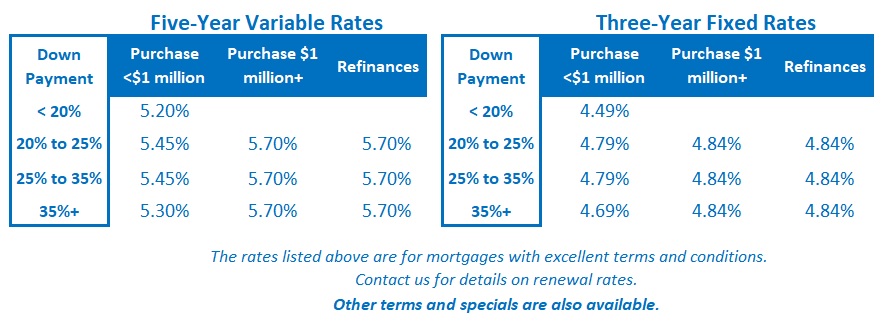Why the Bank of Canada Should Cut by 0.50% This Week
September 3, 2024How Low Will the US Fed Go This Wednesday?
September 16, 2024
Last week the Bank of Canada (BoC) dropped its policy rate from 4.50% to 4.25%, as expected.
Our variable mortgage rates fell by the same amount shortly thereafter.
Our fixed mortgage rates are priced on Government of Canada (GoC) bond yields, so they were not directly impacted by the Bank’s move. But GoC bond yields fell during the lead up to last Wednesday, in anticipation of the BoC cut, and then dropped more after investors digested the Bank’s latest commentary.
Here are five quick thoughts on the BoC’s latest cut, policy statement and press conference:
- The BoC is increasingly focused on downside risks.
The Bank noted our economy’s “healthy rebound” in Q2 and the fact that our GDP came in “stronger than forecast”.
That’s a debatable assessment. Our GDP grew only 2.1% (annualized) in Q2, and most of that growth came from increased government spending. Our GDP-per-capita, which is what individual Canadians feel, declined in Q2 for the fifth straight quarter.
What isn’t being debated is that our economic momentum has since slowed.
BoC Governor Macklem cautioned that “preliminary indicators suggest that economic activity was soft through June and July” and that there is “downside risk” to the Bank’s most recent projections for GDP growth over the second half of 2024.
He acknowledged the “need to increasingly guard against the risk that the economy is too weak and inflation falls too much.” [Italics mine]
- The BoC expects inflation to cool, and it can certainly help in that regard.
The Bank observed that “headline and core inflation have continued to ease as expected”. It anticipates that inflation will “ease further in the months ahead.”
It sees a tug-of-war between excess supply, which is putting downward pressure on inflation, and rising shelter costs “and some other services”, which are pushing overall inflation higher.
Interestingly, more rate cuts would help alleviate both of those competing pressures.
The BoC believes that we will need GDP growth to be sustained “above 2%” for excess supply to be absorbed. Additional cuts will spur more growth.
More rate cuts will also reduce mortgage interest costs, which have risen by 20%+ year-over-year and are causing most of the upward pressure on shelter-cost inflation.
- The Bank noted that employment conditions are deteriorating.
The BoC assessed that “the labour market continues to slow, with little change in employment in recent months.” Our unemployment rate stood at 6.6% in August, marking its highest level in nearly three years.
Soaring immigration has increased our economy’s supply of labour much faster than our economy’s demand for it. Not surprisingly, the hardest hit demographics have been youth and newcomers to Canada.
Thus far at least, “hiring has been weak” but “layoffs remain moderate”.
The Bank expects the increased slack in our labour market will lead to lower wage growth ahead. It came in at 5.0% in August but could drop into the mid-3% range a month from now thanks to base effects, as I detailed in this recent post.
(To briefly recap, base effects are caused when particularly high or low monthly wage-growth prints roll out of a Stats Can data set because it only uses the most recent twelve months of data on a rolling basis.)
- The US/CDN exchange rate isn’t restricting the BoC’s plans.
BoC Governor Macklem was asked whether his rate-cut plans would be impacted by concerns that too wide a divergence between the BoC and Fed policy rates might cause the Loonie to fall hard against the Greenback (and thereby stoke inflation by raising the cost of everything we buy from US markets).
Macklem noted that “we’re not seeing a big impact on our exchange rate” and that “with markets now expecting the Fed to be easing, I don’t expect it’s going to come into play.”
- More rate cuts are on the way, and a 0.50% cut is possible.
As I wrote in last week’s post, our weakening economic data would have justified a 0.50% cut last Wednesday.
The BoC cut by only 0.25% this time. But Governor Macklem took the additional step of saying “it is reasonable to expect further rate cuts”. And when asked about the possibility of 0.50% cut, he acknowledged that “if we need to … we’re prepared to take a bigger step.”
For its part, the bond futures market now expects the BoC to cut by another 1.25% by next June (which would lower the Bank’s policy rate to 3.0%).
Mortgage Selection Advice for Now
The BoC’s latest communications bolster my existing view of our current mortgage-rate backdrop.
Variable rates are likely to fall substantially from their current levels. In my opinion, that justifies paying the upfront premium they still command. If the BoC cuts by another 1.25% (or more), variable rates will outperform all of today’s available fixed-rate options.
With that said, there are no guarantees that events will play out as expected.
If you prefer the stability of a fixed mortgage rate, I think you are well advised to consider three- or four-year fixed rates today. While five-year fixed rates are the lowest on offer, I worry that five years is too long to lock in at this point in our interest-rate cycle. The premiums on one- and two-year fixed rates are still too onerous.
Anyone considering fixed-rate options should also pay extra attention to the terms and conditions in their mortgage contract. They vary widely among lenders and can have a surprising impact on the overall cost of your loan, especially if mortgage rates drop significantly during your term.
If you want to learn more about this topic, my post entitled What’s in the Fine Print is a good place to start. It provides a detailed summary of the terms and conditions to watch out for and links to other posts that dive deeper into the most important ones. The Bottom Line: GoC bond yields fell steadily last week. At this point we shouldn’t be too far away from another round of cuts to fixed mortgage rates (with the usual reminder that lenders take the elevator when they raise their rates and the stairs when they cut).
The Bottom Line: GoC bond yields fell steadily last week. At this point we shouldn’t be too far away from another round of cuts to fixed mortgage rates (with the usual reminder that lenders take the elevator when they raise their rates and the stairs when they cut).
Variable-rate borrowers saw their rates drop by another 0.25% last week. Bond market investors expect that we will see the BoC cut rates by a total of 1.25% by next June. If those cuts materialize, the BoC’s policy rate will drop to 3.0% by then.
I think there is a good chance that the Bank’s policy rate will bottom out at a level below 3% before its current rate-cut cycle is complete.







